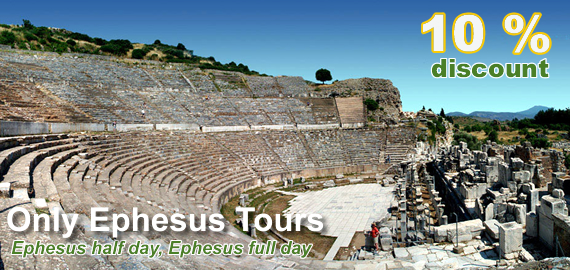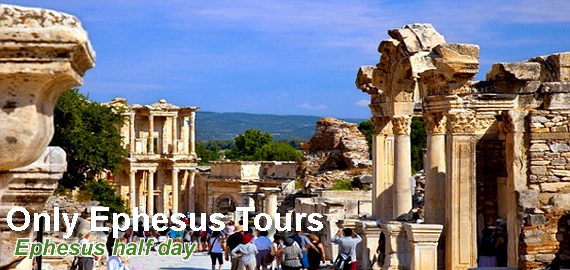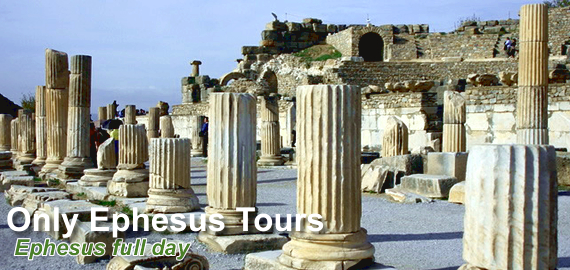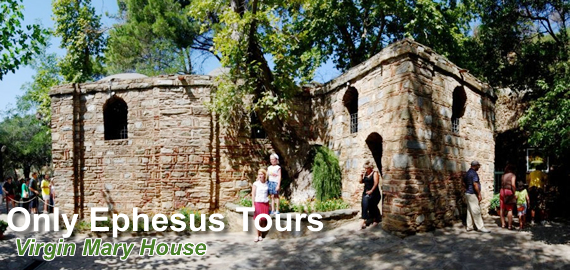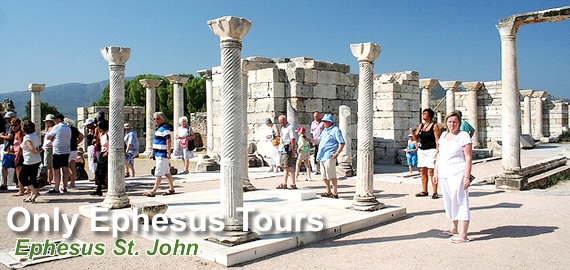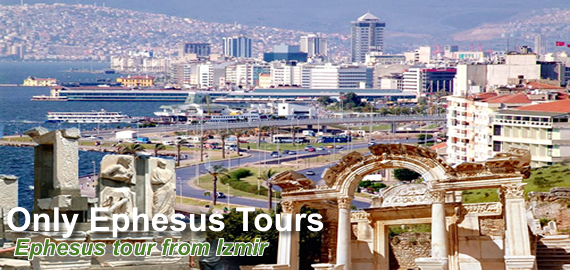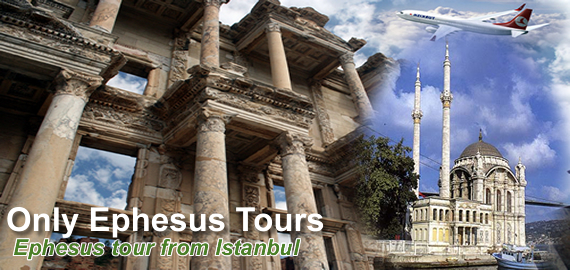Ephesus Information, Ephesus History
 Where is Ephesus, About Ephesus Ephesus Information
Where is Ephesus, About Ephesus Ephesus Information
Where is Ephesus, Ephesus Information, About Ephesus
Ephesus Information, Ephesus History, Ancient Ephesus
The findings obtained in this region where the native people, namely the
Lelegs and the Carians have lived since the beginning, indicate
that the city is dated back to 2000 years B.C. As far as the
years of 1000 are concerned, it is assumed that the Ions came to
this region, lead by Androckles. Ephesus was captured by the
Kimmers (Cimmerians) in the 7th century B.C., by the
Lydians in 560, and later in 546 B.C. by the Persians;
and was rescued from the Persian domination when Alexander the Great
defeated the Persians in 334 B.C.
Lysimachos, a commander of Alexander's, had the settlement
removed from the whereabouts of the Temple of Artemis to the
location between the Mount of Panayir and the Mount of Bülbül,
and had a wall built around the city. The city was taken by the
Kingdom of Pergamon after 190 B.C., by Rome in 133 B.C.,
and later by Byzantium. Ephesus maintained its importance during
the period of Christianity; the apostle St. Paul arrived
there during the years of 50 A.D., and St. John was buried on the
hill of Ayasuluk (Selcuk, near Izmir) at the beginning of the 2nd
century. Ephesus lived through its third glorious period during the
reign of Justinian in the middle of the 6th century A.D. At this
time, the Church of St. John was built by the Byzantine emperor.

The ruins of Ephesus, situated near Selçuk town at 70 kilometers (44
miles) south of Izmir, is a main center of archaeological interest
owing to the ancient remains that still exist. When you enter through
the Magnesia Gate (south gate or upper gate), you can see the State
Agora (or Upper Agora). The Temple of Isis is situated at the center of
the Agora, and Stoa is placed on the North side of it. The Odeion
(Bouletarion or Parliament) with a capacity of 1,400 persons is
placed behind it and the Prytaneion (Town Hall) where the sacred
fire used to burn, is on its flank. The Baths of Varius are placed on
the east side of Odeion.
On the west of the Agora, the Monument of Memmius built in the 1st
century BC., the fountain of Sextilius Pollio built in the year 93 A.D.,
and the Temple of Domitian (81-93 A.D) are placed. On the south
of the Agora, the fountain of Laecanius Bassus is
situated. The Curetes street starts downwards from the Temple of Memmius.
The Gate of Heracles (Hercules) is placed on this avenue. After passing
through this part, the fountain of Trajan built in the years 102-114 is
seen on the right hand side and after this, the Temple of Hadrian
appears in front of us, in all its splendid beauty (117-138 A.D).
The Scholastica Baths, built in the 4th century A.D., are
situated behind the Temple of Hadrian. The houses of the rich people of
Ephesus which were in front of it, have been restored and opened for
visits at present with special permits.

At the corner formed by the Curetes street and the Marble Road,
the House of Love (Pornaion or Brothel) is placed and the
Library of Celsus, restored and reestablished in recent years,
stands right in front of this. The library which had been built in the
name of proconsul Gaius Celsus completed in the year 135 A.D. by his son
Tiberius Giulius Aquila, is entered by way of a stairway, 21
meters (69 feet) in width and having 9 steps. The southeastern gate of
the Trade Agora opens to the Library of Celsus. Emperor Augustus'
slaves, Mazaeus and Mithridates, liberated by him had this gate
built in the year 1st century A.D.; it comprises three sections and has
been restored today. The Corinthian columns of the Stoa encircling the
Trade Agora with the dimensions 110 x 110 meters (361 x 361 feet), are
standing erect today. The Temple of Serapes built in the period of
Antony (138-192 A.D.) is placed behind the Trade Agora.
One of the magnificent buildings of Ephesus is the Great Theater,
largest in Asia Minor, which had a capacity of more than 24.000
people and is in a rather well preserved condition. The construction
had started during the Hellenistic period but it could only be completed
during the time of Trajan (98-117 A.D.).
 St. Paul was
dragged into this theater to face the crowed because of his famous
letter to Ephesians, but rescued by the security corps of the city.
Festivals are celebrated in this theater today.
St. Paul was
dragged into this theater to face the crowed because of his famous
letter to Ephesians, but rescued by the security corps of the city.
Festivals are celebrated in this theater today.
All the streets of Ephesus were illuminated at night with oil lamps,
this shows us the richness of the city. The Port Avenue extends in front
of the theater. The avenue is 11 meters (36 feet) wide and 600 meters
(1970 feet) long, and it has been called Arcadian Street
because it was renewed during the time of Arcadius. On the whole
north side of the avenue, there are the Harbor Gymnasium, baths
and the Theater Gymnasium. The avenue that passes along the front of the
theater, extends towards the Stadium built during the Nero period
(54-68 A.D.) and towards the Vedius Gymnasium. The Church
of the Virgin Mary built at the beginning of the 4th century A.D. is
situated behind the Port Gymnasium just before the exit from the
lower gate (north gate). This was also the meeting place of the 3rd
Ecumenical Council.
THE MOST CREATIVE AND ECONOMICAL EPHESUS TOURS FOR
YOU!
We provide you with the air conditioned vehicle with the driver and
the licensed professional English speaking guide. You can draw up the
program and determine the sights you wish to visit; our guide and the
private vehicle with the driver will be at your disposal.
This kind of Ephesus tour is for those who is short of time or just have
special wishes about what to visit around Kusadasi and Ephesus.


